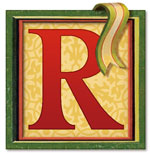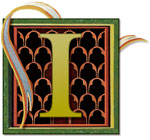Passageways: Recent Paintings by Richard Whitten – Curator’s Statement
Curator’s Statement: Wondrous Journeys to Impossible Realms

ichard Whitten’s paintings integrate features derived from a diverse array of pictorial and architectural sources. Architecture of the Romanesque period and Italian Renaissance, linear perspective invented by Filippo Brunelleschi about 1425, and Giovanni Battista Piranesi’s etchings of imaginary prisons in the Carceri series of the 1760s are among the most obvious. We can also detect the lurking influence of 20th-century luminaries like Giorgio de Chirico, René Magritte, Francis Picabia, and Joseph Cornell, more explicit homage to the trompe l’oeil (fool the eye) effects introduced by Georges Braque and Pablo Picasso, together with the incorporation of ornamental patterns ranging from stylized fleurs-de-lys to boldly printed wall paper. Such an amazing orchestration of sources is frankly postmodern in spirit.
Whitten has described the subject of his paintings as “the organized space of interior architecture.” Yet, our experience as viewers of these works belies concerns of a purely formal nature. Through the structure of his architectural interiors Whitten controls the direction of our gaze. He presents us with keyhole views into physically impenetrable spaces. Perspective encourages us to enter visually into parts unknown. The spatial design may beckon us to follow the path of a curving corridor or to peer around a corner that promises to take us in a different direction. Many spaces are merely implied, not yet visible. Whether approachable via infinitely receding passageways or beyond our immediate sight, they arouse curiosity and wonder. They elicit associations and memories. Most of all they appeal to the imagination because only through imagination can we experience them.
The size of Whitten’s paintings ranges from the diminutive scale of religious icons to the monumental scale of a 15th-century altarpiece. Like devotional objects from the past, which they inevitably call to mind, they are meticulously painted on wood panels and incorporate precious materials, namely copper and gold leaf, in combination with oil paint. Sometimes two or more panels appear to be hinged together as in an actual altarpiece, but their shapes are not derivative. By cutting the contours into inventive configurations Whitten treats his panels as objects with a sculptural presence. Ornamental patterns surrounding the interior passageways, much like marginalia in medieval illuminated manuscripts, sit unambiguously on the panel’s physical surface. They accentuate the object quality of the paintings by calling attention to the picture plane as a two-dimensional support rather than a rectangular window opening onto a spatially consistent world.
Like Braque and Picasso before him, Whitten further accentuates the panel’s identity as a flat physical object by printing his titles directly on the surface or by introducing trompe l’oeil effects such as metallic labels that appear affixed directly to the wood. Evocative of other times and places, these labels present the titles of the works in carefully lettered French, Italian, German, or Latin words, and sometimes bear the artist’s initials and date of the painting in Roman numerals. While alluding to the past he simultaneously grounds us in the here and now by introducing the illusion of tangible, three-dimensional objects – most often gaily striped toy balls – that appear to hover in our own space, casting their shadows on the panel. The spatial dynamics of Whitten’s paintings thus lead us on a wondrous journey from the space we occupy, to the undeniably flat surface of the shaped wood support, and beyond it to impossible realms accessible only in the mind’s eye.
Ann H. Murray
Professor of Art History
Artist’s Statement
In general, it is thought that the novelty of the content of one’s life is what makes “the time pass”; that is to say, shorten it; whereas monotony checks and restrains its flow. This is only true with reservations. A time in a person’s life that is very full seems to go quickly, but is long in the remembering. In contrast, a time that is empty is seemingly endless, but can be described in an instant.
Paraphrased from The Magic Mountain by Thomas Mann, 1926

have always been fascinated by the fact that, even in the largest of paintings, architectural space, when portrayed, is actually much smaller than it is in reality or in how the viewer perceives it. In contrast, things that are small can successfully be portrayed to be much larger than they are. This conundrum—this juggler’s balance, has become, for me, a fount of ideas—a source of creativity.
My paintings are about play. My paintings are, in some ways, very serious toys. This does not mean, however, that they are frivolous. Play is a very serious activity—an impetus for learning and exploration. Neither is play nor my painting all about fun. These paintings imply the existence of other places—”invisible cities” that can be visualized, but, like the garden in Alice in Wonderland, can only be desired—not reached. As I begin to design these spaces, I answer simple demands: to look down, to look around a corner, to look around a curve. The imagined architecture is designed to make the viewer look in a specific direction; to feel curious about what is partially hidden; to feel exhilarated by a vast expanse. As the images develop, they also take on references to the past: intimate niches, the vast vistas of the Renaissance painters, or the dramatically lit Baroque spaces of Piranesi—spaces that have a sense of history and place and meaning.
The shape of the painting, “Il Dédalo,” is a spiral, and that spiral is echoed by, or echoes, the painted illusion of a curving rotunda. The balance and proportions are complex—carefully measured and related—a composition highly dependent on mathematics. It sounds so serious—and is. Nevertheless, what might be the purpose of the giant ball except to go careening through that entire space like a great marble?
I do not wish to simply make pictures of architecture. The paintings are meant to be enjoyable. I wish the viewer to have an almost physical sense of the transition between his or her own world and that of the painting. The viewer’s passage starts here, in this world, with the sculptural reality of the shaped panel and continues through the marginalia to the goal—a space—a temple to art? This is the most difficult part of making these paintings—the orchestration of disparate elements to fit seamlessly. At first the viewer is meant to simply accept the paintings. Only later should he or she realize the need to question why the elements that are present seem to make sense but don’t. Perhaps the viewer, pleasantly surprised, will realize that I owe as much to Twentieth Century artists such as Joseph Cornell and Josef Albers as to Piranesi.
Thank you for enjoying these passageways with me.
Richard C. Whitten